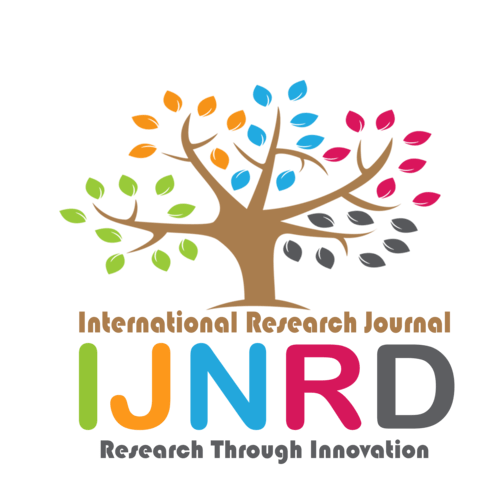|
|||||||||||||||

|
INTERNATIONAL JOURNAL OF NOVEL RESEARCH AND DEVELOPMENT International Peer Reviewed & Refereed Journals, Open Access Journal ISSN Approved Journal No: 2456-4184 | Impact factor: 8.76 | ESTD Year: 2016 Scholarly open access journals, Peer-reviewed, and Refereed Journals, Impact factor 8.76 (Calculate by google scholar and Semantic Scholar | AI-Powered Research Tool) , Multidisciplinary, Monthly, Indexing in all major database & Metadata, Citation Generator, Digital Object Identifier(DOI) |
||||||||||||||
Issue: April 2024
Volume 9 | Issue 4
Review Result and Publication of Paper within : 2-3 days
Click Here For more DetailsFor Authors
Forms / Download
Published Issue Details
Editorial Board
Other IMP Links
Facts & Figure
Impact Factor : 8.76
Issue per Year : 12
Volume Published : 9
Issue Published : 95
Article Submitted :
Article Published :
Total Authors :
Total Reviewer :
Total Countries :
Indexing Partner
Join RMS/Earn 300
Licence
This work is licensed under a Creative Commons Attribution-NonCommercial 4.0 International License







|
Published Paper Details
|
|
| Paper Title: | INDOOR AIR QUALITY OF RESIDENTIAL TYPOLOGIES: A COMPREHENSIVE REVIEW |
| Authors Name: | BINDU , Tejwant Brar |
| Download E-Certificate: | Download |
| Author Reg. ID: |
IJNRD_190642
|
| Published Paper Id: | IJNRD2306144 |
| Published In: | Volume 8 Issue 6, June-2023 |
| DOI: | |
| Abstract: | People worldwide spend roughly 90 % of their time in various indoor locations. For health, comfort, and activity levels at home, in offices, schools, and hospitals, now more than ever, cleaning the air inside your home is a priority. The air outside dramatically affects the mood inside, and people with poor indoor air quality (IAQ) have long-term health problems. Most people have health problems because they spend so much time indoors, where the air seems more likely to be polluted. According to a study, in developing nations like China and India, indoor air pollution (IAP) was already connected to an increase in respiratory health issues. The Environmental Protection Agency (EPA) and the World Health Organization (WHO) have set up many standards to control indoor air pollution (IAP) [1], [2].Local, state, and federal governments could use these standards as guidelines. The health risks of remaining relaxed in a polluted environment may be severe. Indoor pollutants are a vital contributor to illness in many parts of the world. No matter what season it is, the interior materials and products affect the air quality. In those places where people don't have enough ventilation, they have a more challenging time going about their daily lives and getting things done. Indoor pollutants, such as interior materials, dilute indoor air quality and human performance. Polluted indoor air can affect people's health with headaches, runny noses, tiredness, eye pain, coughing, unpleasant reactions, and asthma. Children may be more sensitive to the health dangers and risks of pollutants found within than adults[3]. The review study focuses on improving living conditions by enhancing the air quality within buildings and creating pleasant environments to spend time inside. Using ventilation systems regularly helps make living spaces more comfortable for people in the winter and summer. Occupants may be at risk for sick building syndrome (SBS) if the air inside the building is polluted[4]. Pollutants can come from the outside air, but they can also be made inside by things like heating, ventilation, food, and the fumes from construction goods and materials. People spend most of their lives in controlled environments, so indoor activity dramatically affects their health and performance. Even though researchers have looked at indoor air quality (IAQ) from many different angles for years, there has yet to be a thorough analysis of peer-reviewed IAQ studies that focus on the effectiveness of the internal characteristics of different residential building contexts on IAQ. This paper review would help researchers worldwide understand how IAQ research has changed and its limits. It also highlights the trends and research gaps in indoor air quality (IAQ). I can also judge the IAQ of housing units in different countries and regions by looking at the data in the relevant literature, which reflects a much better understanding of IAQ worldwide. This review can be beneficial to architects and building designers by developing laws for the air within residential buildings that take into account all of the sources of pollution found inside residential buildings to produce building settings that are both sustainable and healthy. |
| Keywords: | Indoor air quality; Parameters; Indoor air pollution ; Influencing factors indoor; Residential Buildings. |
| Cite Article: | "INDOOR AIR QUALITY OF RESIDENTIAL TYPOLOGIES: A COMPREHENSIVE REVIEW ", International Journal of Novel Research and Development (www.ijnrd.org), ISSN:2456-4184, Vol.8, Issue 6, page no.b403-b413, June-2023, Available :http://www.ijnrd.org/papers/IJNRD2306144.pdf |
| Downloads: | 000118749 |
| ISSN: |
2456-4184 | IMPACT FACTOR: 8.76 Calculated By Google Scholar| ESTD YEAR: 2016 An International Scholarly Open Access Journal, Peer-Reviewed, Refereed Journal Impact Factor 8.76 Calculate by Google Scholar and Semantic Scholar | AI-Powered Research Tool, Multidisciplinary, Monthly, Multilanguage Journal Indexing in All Major Database & Metadata, Citation Generator |
| Publication Details: |
Published Paper ID:IJNRD2306144 Registration ID: 190642 Published In: Volume 8 Issue 6, June-2023 DOI (Digital Object Identifier): Page No: b403-b413 Country: Hissar, Haryana, India Research Area: Engineering Publisher : IJ Publication Published Paper URL : https://www.ijnrd.org/viewpaperforall?paper=IJNRD2306144 Published Paper PDF: https://www.ijnrd.org/papers/IJNRD2306144 |
| Share Article: | |
|
Click Here to Download This Article |
|
| Article Preview | |
|
|
|
Major Indexing from www.ijnrd.org
| Semantic Scholar | Microsaoft Academic | ORCID | Zenodo |
| Google Scholar | ResearcherID Thomson Reuters | Mendeley : reference manager | Academia.edu |
| arXiv.org : cornell university library | Research Gate | CiteSeerX | PUBLON |
| DRJI | SSRN | Scribd | DocStoc |
ISSN Details
 |
 |
ISSN: 2456-4184
Impact Factor: 8.76 and ISSN APPROVED
Journal Starting Year (ESTD) : 2016
DOI (A digital object identifier)
Conference
Open Access License Policy
Important Details
Social Media
| Copyright © 2024 - All Rights Reserved - IJNRD |












Facebook Twitter Instagram LinkedIn